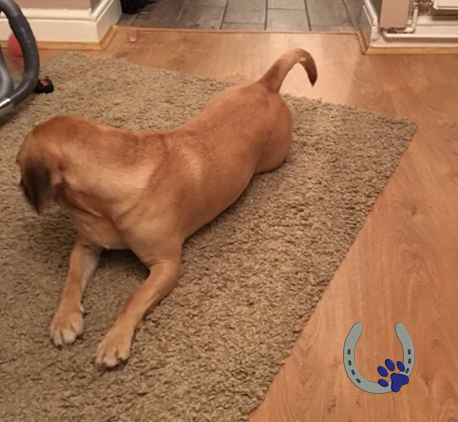The Broken Wag- Limber tail syndrome
- Beth Edwards
- Oct 13, 2017
- 4 min read
Limber tail syndrome. Have you heard of it? Surprisingly, not many people have. It may also be called acute caudal myopathy, cold tail, limp tail and broken tail. Some people may refer to it as a tail sprain but this causes confusion as a sprain is usually associated with the joint whereas LTS is a muscular condition. The muscles of the tail are affected, causing the typical limp tail stance as seen in the photos. It most commonly affects undocked sporting dog breeds such as Labradors, English pointers, beagles, golden retrievers, setters and fox hounds, particularly after numerous water retrieves at the beginning of the season. This however, does not mean that your pet dog can’t suffer from LTS. The photos below are of a Puggle (Beagle x Pug) who suffered from LTS after swimming in cold water. The main aim of this article is to raise awareness of LTS to hopefully reduce the chances of it occurring in both pets and working dogs.


How does a dog get LTS?
LTS is generally caused by a mix of strenuous activities, especially if the dog’s fitness wasn’t quite up to it. In a working dog, it is commonly reported at the beginning of the season because even though the dogs are fit and healthy, they just weren’t used to or ready for the challenge of their jobs, which may include: water retrieves, inclines and declines, challenging terrain and for a prolonged period. As the dogs love their jobs and have so much enthusiasm, both the dog and the handler have no idea that the dog is doing too much, causing overexertion and damage to the coccygeal muscles near the base of the tail.
It is very similar circumstances when it is reported in pet dogs. It is still most commonly reported around this time of year (due to the temperature drop). Here’s an example: The dog has done less during the week due to busy family life, kids back at school, nights go darker earlier etc. So at the weekend, the whole family take the dog out for a lovely walk, they may even go with a friend and take their dog too. The dogs have a wonderful time racing each other up and down the hills, through the fallen leaves in the wood and then enjoy a nice cool down swim in the river and a little paddle in the mud. Again, because the dogs show so much enthusiasm, nothing is thought of it. The signs and symptoms develop rapidly after the exercise, the dog may seem restless and by the morning, the owner will be distraught to find “the broken wag”. Indeed, it is upsetting to see the dog’s tail so limp because you have only ever seen it wagging! At that point it is important to monitor your dog and check he is still acting his normal self. Most dogs with LTS but who are still fine within themselves don’t often get prescribed any pain relief. Each case is different and each dog may suffer with a different severity of the syndrome.
Another cause of LTS which is less commonly reported is prolonged cage confinement. This was reported in field trial dogs which had to travel a long distance to competitions.
Is it painful?
Dogs suffering with LTS usually show signs of discomfort around the base of the tail. It may be swollen and the hairs in that area may stand on end (as seen in the photo below). The base of tail may feel hot to touch. Occasionally, the dog may nibble at the area. In most cases, the dog is unable to wag his tail. The tail may be completely limp from the base or begin to limp further down. As the tail feels uncomfortable and sore, the dog may have difficulty laying and sitting.

Is there any treatment?
Depending on the case, some dogs may be prescribed an anti-inflammatory or pain relief from the vet. Rest is advised but with frequent lead walking to keep him active to prevent other problems arising. It is important to isolate the cause to prevent reoccurrence! Once the causation factor or factors have been found, it may be easy to prevent it happening again.
How long does it last?
LTS has been reported to last between a few days, up to 10 days. The dog slowly regains his tail wag and in most cases, is back to normal within seven days.
Does it reoccur?
LTS can reoccur but the dog is not more susceptible to it once he has suffered from it. The dog will only suffer from it again if similar conditions and factors occur.
How to prevent?
Regular exercise helps maintain a good fitness level. If you are trying to build up your dog’s fitness, do so gradually and seek advice from your vet and vet physio. Be cautious when letting your dog play off the lead with others, this is particularly important if there is a huge size difference (little legs have to work a lot harder to keep up with long legs!).
If you have any questions or would like more information, please contact us, we would love to help. Derbyshire Veterinary Physiotherapy















Comments